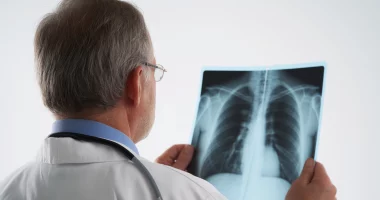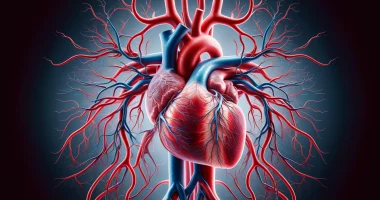De Quervain’s tenosynovitis
Definition
De Quervain’s tenosynovitis is a narrowing of the canal in which the tendons of the thumb pass. It is accompanied by inflammation of the tendon sheaths. It occurs due to the constantly increased load on the hand, often in connection with the performance of professional duties. Usually develops gradually. The course is chronic. The disease is characterized by pain at the base of the first finger and a small local swelling. Due to the pain, patients have reduced or lost the ability to perform a number of movements involving both the first finger and the entire hand. The diagnosis is based on complaints and patient examination; no additional tests are required. Conservative therapy is effective in about 50% of cases. The radical method of treatment is surgery.
General information
De Quervain’s disease (chronic tenosynovitis, stenosing tendovaginitis, stenosing ligamentitis) is a narrowing of the canal in which the tendons of the hand’s first finger are located. The cause of the disease is constant traumatization of the canal during the movement of tendons in it. The disease develops gradually and runs chronically. Women suffer more often than men and older people suffer more often than young people. The disease is usually found to be related to the nature of work or increased load on the hand when performing household chores.
Causes
In modern traumatology and orthopedics, the dominant opinion is that de Quervain’s disease is predominantly occupational. The disease is usually observed in pianists, housekeepers, milkmaids, laundresses, seamstresses, plumbers, field workers, painters, etc. At the same time, this pathology can also be detected in non-working women. In the latter case, the development of the disease is associated with performing household duties and carrying small children in their arms.
Symptoms of de Quervain’s disease
The disease develops gradually. Usually, patients first come to the office a few days or weeks after the onset of symptoms. In about 7% of cases, an acute onset is associated with a previous hand injury. When collecting the history of the disease, it turns out that at first, the patients were bothered by pain only when significantly extending and withdrawing the thumb and when sharply withdrawing the hand to the side of the little finger. Subsequently, the pain syndrome progresses and occurs even with minor movements.
Patients complain of pain in the lower part of the forearm and the projection of the wrist joint on the side of the thumb. The pain may occur exclusively during movements or pressing, aching, constant, not disappearing even at rest. Occasional awkward movements may also cause sharp pain in sleep. In more than half of the cases, the pain radiates downward to the outer surface of the first finger or upward to the forearm, elbow, and shoulder.
Diagnosis
The examination must be carried out in comparison of both hands – this makes it possible to accurately detect changes in the affected hand that are sometimes not too pronounced but are characteristic of de Quervain’s disease. In the area of the wrist joint on the side of the first finger, a slight to moderate local edema is determined. The anatomical snuffbox is smoothed or is not detected due to swelling. The skin over the affected area is unchanged; no localized fever exists. Rare cases of desquamation, redness, and local hyperthermia are not due to the disease itself but to self-treatment, which patients sometimes undertake before seeking medical attention.
Palpation reveals pain in the area of the lesion, reaching its maximum in the projection of the styloid process of the radius. Pressing on the tendon area of the first finger is painless. A dense and smooth round-shaped formation is palpable below the styloid process – the dorsal ligament thickened in the canal area. After examining the affected area, the patient is asked to put his hands down and deflect the hands alternately toward the little finger and thumb. The patient’s hands are deflected almost equally towards the first finger. In case of deviation towards the little finger, a 20-30 degree limitation of movements compared to the healthy hand is detected, and the movement is accompanied by pronounced pain.
In addition, the affected hand shows a limitation of thumb extension. To detect this symptom, the patient is asked to place the hands on a rib with the palms facing each other. When moving, a significant limitation of abduction is noticeable (the difference between the sick and healthy side is from 40 to 80 degrees). The difference when extending the first finger is not so striking but also visible to the naked eye.
Another test to confirm the diagnosis is the Finkelstein test. The patient presses the thumb against the palm tightly, squeezes it with the other fingers, and then withdraws the hand toward the little finger. The movement is accompanied by sharp pain in the area of the lesion. Also, with this disease, a violation of the ability to hold objects with the help of the first finger is detected. The patient is asked to simultaneously take some objects (for example, pens or matchboxes) with both hands, first and second fingers. When pulling on the object, pain and weakness in holding on the affected side are detected. The diagnosis of de Quervain’s disease is made based on clinical findings. No further investigations are required.
Treatment of de Quervain’s disease
Treatment is carried out by an orthopedist or traumatologist. Conservative therapy is performed on an outpatient basis. The patient is put on a plaster or plastic splint for 1-1.5 months, ensuring the rest of the affected limb, and subsequently recommended to wear a special bandage for the I finger. In addition, the patient is prescribed nonsteroidal anti-inflammatory drugs (ibuprofen, naproxen, etc.). In case of severe pain syndrome, local blockades are performed.
If conservative therapy is ineffective, surgical treatment is indicated. Surgery is performed in hospital conditions in a planned procedure. Usually, local anesthesia is used. Before anesthesia, the doctor marks the most painful point and, after the introduction of novocaine, performs an oblique or transverse incision over the area of the styloid process, passing through this point. Then, he carefully pulls aside the subcutaneous tissue with veins and the superficial branch of the radial nerve with a blunt hook and exposes the dorsal ligament. The ligament is dissected and partially excised.
If the disease is prolonged, adhesions between the tendon, tendon sheath, and the periosteum may occur in the lesion area. If detected, all adhesions are carefully excised. The wound is sutured layer by layer, ensuring the tendon is completely free to move. The arm is placed on a bandage. Sutures are removed on the 8th-10th day. The ability to work is usually restored 14-15 days after surgery. In the postoperative period, there may be numbness and crawling of goosebumps in the area of the first, second, and half of the third finger, caused by anesthesia or compression of the superficial branch of the radial nerve. These symptoms disappear within 2-3 weeks.
All these treatment options are available in more than 800 hospitals worldwide (https://doctor.global/results/diseases/de-quervains-tenosynovitis). For example, De Quervain’s tendon release can be done in 40 clinics across Germany for an approximate price of $4.6 K (https://doctor.global/results/europe/germany/all-cities/all-specializations/procedures/de-quervains-tendon-release).
Prognosis and prevention
The prognosis is favorable. Conservative treatment shows a satisfactory effect in 50% of cases. After surgery, good recovery is usually observed. It should be considered that a chronic pathological process in the area of the annular ligament causes the disease. If the patient still overloads the arm after surgery, the disease may recur. For this reason, patients are usually advised to change their occupational activities and to reduce the load on their hands during household tasks.

